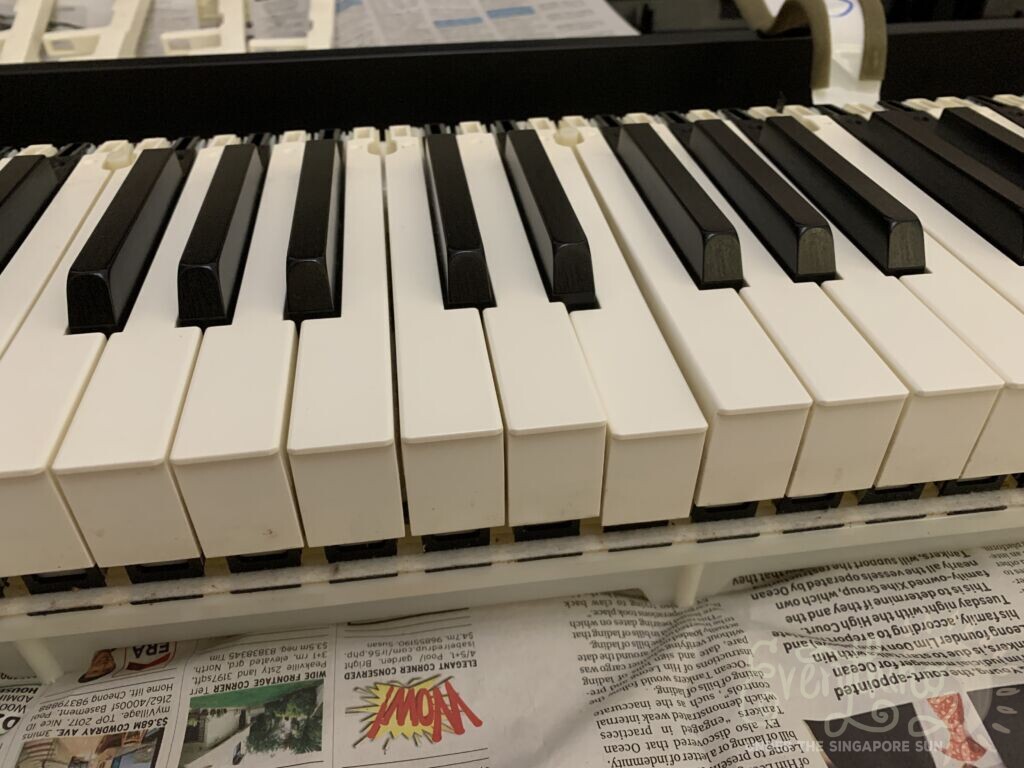Right, so this is the real reason why my blog is called “Everything Under the Singapore Sun”.
Anyway, here is my second hand Casio Privia with a dumb sunken key. In fact, it had over 8 sunken keys and the rubber hammer caps just keep breaking because it was quite old. This fix is so fantastic because it works with most Casio Digital pianos that uses rubber hammer caps, and it is soooo cheap and easy!

A sunken key is usually due to a broken hammer cap which, to my shock, costs over $200 a pack and $5 each. Apparently they disintegrate over time so if your piano is around 7 years old, they will start having issues with sunken keys. Apparently this is a super common problem with Casio Digital Pianos with weighted keyboard action and many “experts” can fix it but they will charge you at least $200 for a trip. Not worth it for a 7 year old piano I bought on Carousell for $300, right?

So I decided to go at it myself because I like to see how things work, but mainly I am a true cheapskate. I basically invented this method and is durable and oh so cheap!!!
What you need
All you need are small cable ties (2-3mm wide) and some lubricant like petroleum jelly aka Vaseline.
Instructions
If these instructions are too tough to understand, watch the video right at the bottom of the post!
Now you need to open up your piano. Depending on your piano model, it may open up differently so search YouTube on how to do that. This is going to be the most tedious and hardest part of your DIY repair because the piano has a frickin’ amount of screws and I highly recommend an electric screwdriver (which I wish I had). Once you have finally access to the keyboard, pry out the sunken key and take out whatever is left of the sunken key.


Now, zip one tie around the notch you see there and another nearer to the front. Turn the cable tie so that the head is at the top, pull tight, make sure it isn’t going anywhere and cut off the excess. One cable is going to be lower and the other is slightly higher due to the shape of the hammer key. That is normal.


Put some Vaseline on it and put the key back. In fact, this fix worked so brilliantly (if I say so myself) that I went ahead and changed all the white keys so that I don’t have to open up my piano ever again! I’m sure it will last longer than those stupid rubber hammer caps that keeps breaking.
I really hope this post helps you! Please let me know in the comments.




Is that cable tie head acting as the weight?
There is no “weight” even on the hammer caps. The hammer caps are thin rubber caps. The cable ties are meant to replace the rubber hammer caps. The weight is on the back of the action, not the front.
This is brilliant! I have 8 sunken keys on my Casio privia. Brought It this morning to a repair shop which told me that I need to pay an $85 admin fee. And if after they open up my piano and I do not accept their quotation for repair, they cannot refund my admin fee. I told them to fly kite cos they had asked me to bring the piano down to their shop for an assessment and quotation. And now, they are saying the quotation costs $85! I say spending $0.20 as you described here is infinitely smarter.
Is there any shop that repairs Casio-CDT 100 piano or buys piano with broken keys?
I have 8 sunken keys in my Casio CDT-100 piano. I don’t know how to repair them. I need help to open the piano. What should I do or do you have any advice?
I suggest you look at videos or something on how to open. For my keyboard, I literally have to take out every single screw on the casing, and some are hidden so it is hard to spot.
Thanks for this post, I was able to fix our keyboard that was just collecting dust for years because of the sunken keys due to those ‘melted’ plastic guides. Now the kids can play the piano again!
For the black keys though, I replaced it with a single slightly bigger sized cable tie and somehow seemed easier than fitting 2 small sized ones as I did for the white keys.
Apart from difficulty finding the original plastic guide part locally, it’s very costly and for sure it wouldn’t last long also, so the cable tie fix was actually better.
Again, thanks for sharing!
Glad that I could help! I didn’t fix my black keys because I had no sunken black keys but that’s good to know for when I fix it in the future.
Hi, I tried your trick but it didn’t seem to be stable as I could easily pull the cable out. At the time I decided to use a real hammer cap replacement. I now have a few more sunken keys and it is true that replacements are way too expensive. how do you make sure they don’t slide out?
There is a notch and I pull the cable tie really tight using pliers. I also used two for added security. It should work as none has come out so far for me.
i tried using the cable tie method but some came loose. i found 3d files that seems to be for the hammer caps. https://grabcad.com/library/casio-ap500-hammer-caps-1. I have sent them for printing and hope it works.
What material have you used for printing? Did it give you good results? Original replacement parts are so expensive! Thank you!
First, 🥰 thank you very much for sharing this. It has helped me solve the white sunken keys. I also changed those for the black one but some of them won’t budge anymore. They’re not sunken. They do not bounce back. I need to pull them up. 😅 Please confirm. The size of the cable tie head matters, does it not?
Yes, your cable tie is probably too big and getting stuck as the black keys are smaller 🙂
Does this solution change the feel of the key when playing?
Hi max, it does affect the sound as rubber is slightly softer. So when you hit the keys, there is a louder “tak” sound. But no real change in feel and the hammer action.
I discovered that an eraser cut to the shape of the degraded rubber piece and properly lubricated will actually quiet the key slap and is very easy to shape. Your fix is a great idea of course and will most likely outlast the original rubber feet.
Hi. I have to repair a number of white keys on a Celviano AP200, and found the same problem trying to source the hammer caps. Your solution using the cable ties is great, and I’ll be doing that shortly – thanks for going to the trouble of posting the article.
Your solution is really great, I have repaired a sunken key succesfully. Being a pianist, I’d say the feel of the key is 97% the same as original (I find the response is slightly slower in repetitions, maybe I should have lubricated more), and that’s a lot to say taking into account how difficult it is to find the original part, and how damn expensive they are. If we were to replace 88 caps, we’d be paying a third of a new piano for the parts…!
Thank you very much.
Where do you apply the Vaseline?
At the top of the cable ties where it contacts the key.